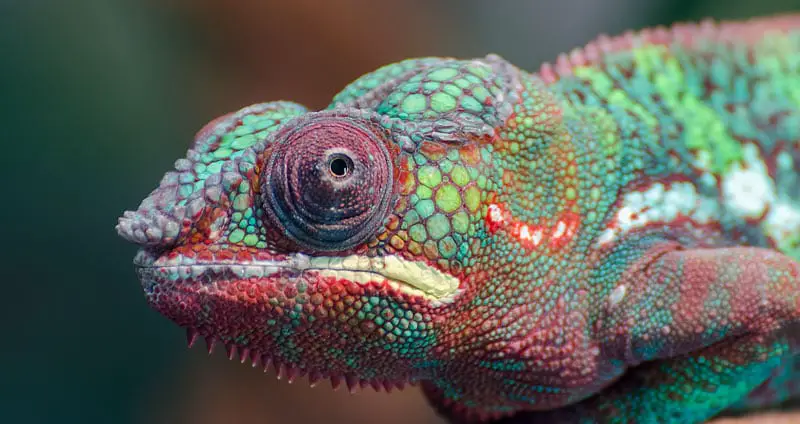Chameleons are interesting creatures that not a lot of people know much about. If you own or are looking to own a chameleon, there are a few questions that you may have regarding their care.
One large area of uncertainty surrounding chameleons has to do with their reproduction. Specifically, many people wonder whether or not chameleons lay eggs, since reptiles in general have diverse reproductive processes.
Do Chameleons Lay Eggs?
In short, yes, every single chameleon species will lay eggs. However, not all chameleon eggs are the same, so it helps to know what your specific species does in terms of reproduction.
There are two types of chameleons when it comes to reproduction — oviparous and ovoviviparous. Both lay eggs, but one’s in the traditional sense and the other’s a bit unique.
Oviparous chameleons are species that lay eggs in the way that most other animals do. These chameleons tend to lay eggs yearly with or without the presence of a male, much like chickens lay unfertilized eggs.
However, if the eggs do happen to get fertilized, the chameleon will lay its eggs about 3 to 6 weeks after copulation. It will deposit its eggs into a hole that it digs, and from there the eggs will hatch.
Quite a few factors here depend on the species of chameleon. For example, different species will lay different amounts of eggs. Brookesia Chameleons may only lay a couple of eggs, while Veiled Chameleons lay between 20 and 200 at a time.
Additionally, different species’ eggs take varying amounts of time to hatch, but typically do so after 4 to 12 months.
Ovoviviparous species, on the other hand, don’t lay eggs like other species. Instead, they keep the eggs inside of their bodies until the embryos are about to hatch! This results in a middle ground between laying eggs and giving live birth.
These species, such as the Jackson’s Chameleon, have 5 to 7 months gestation periods.
Each chameleon born this way emerges from their mother while covered in the sticky, transparent membrane of their egg sack. The mother chameleon then presses the egg sack against a tree branch where it sticks until the baby chameleon emerges and goes to find food.
How To Know When You Chameleon Is Gravid
A gravid chameleon is essentially a pregnant chameleon, or a chameleon that’s currently carrying eggs. It’s important to know when your chameleon is gravid, as it will allow you to accommodate its specific needs well.
If you aren’t aware if your chameleon is pregnant, then serious problems can arise in the future when they try to lay their eggs.
It’s not extremely obvious when your chameleon is gravid, but it is still visible. Gravid chameleons will be noticeably rounder and fatter, weighing more than they usually do.
The beginning stages of pregnancy won’t be very noticeable, but advanced stages will start to show quite well. It’s especially noticeable if you spend a lot of time with your chameleon and know how much they normally weigh.
Another, more accurate way of checking to see if a chameleon is gravid is by weighing them. Weighing your chameleon once every two weeks or so is a great way to check for pregnancy and to make sure that they’re staying healthy.
Sudden increases in weight without a change in diet are usually indicative of pregnancy.
Chameleon Egg Laying & Egg Binding
When oviparous chameleons are ready to lay their eggs, they’ll start to dig a surprisingly deep hole to bury their eggs in. Chameleons are quite picky about this spot, as they’ll only pick it once and will ensure that it’s safe enough and the right temperature for their eggs.
In captivity, you need to do the job of providing the optimal egg burying spot. Usually chameleon owners will supply a separate bucket that’s filled with soil that can easily be dug into.
On top of the deep soil, there are several other factors that you need to ensure are provided:
- A long, wide container of moist soil that’s at least 6 inches deep
- A diet with plenty of calcium
- Plenty of moisture in the enclosure
- Adequate temperature
- A calm environment
If a chameleon doesn’t have a good location to lay their eggs, then they’ll decide to keep their eggs inside of them. This is a serious problem! This is called egg binding, and it can cause very bad health problems in chameleons.
There are two main reasons why a chameleon would become egg bound. First of all, their environment may not be optimal for egg laying. In this case, you’ll need to make sure that you’re meeting all of the requirements that are laid out above. You need to encourage egg laying as fast as possible.
Additionally, a chameleon may experience egg binding because they aren’t receiving enough calcium in their diet. A lack of calcium will result in weaker muscles that can’t push the eggs out of the chameleon.
If this is the case, then you should take your chameleon to a reptile specialist to have them perform an X-ray to see just how many eggs are stuck. A shot of calcium can also be supplied to help facilitate egg laying.

